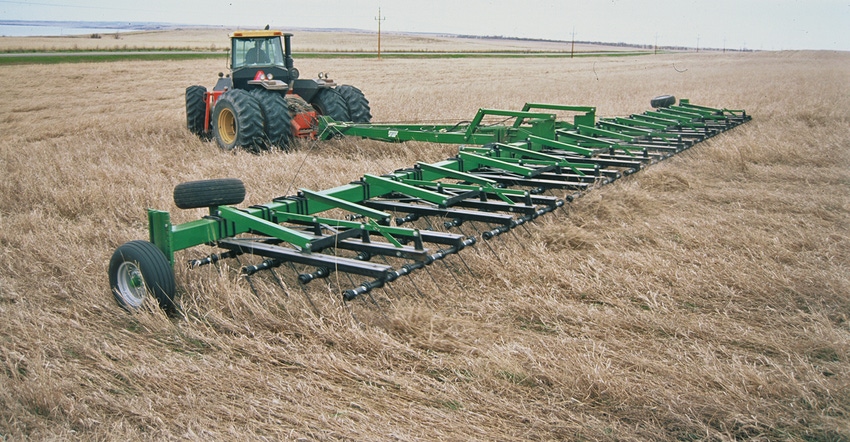August 30, 2018

Abbey Wick, North Dakota State University Extension soil health specialist, has six tips for seeding cover crops after harvesting small grains.
1. Deal with residue before seeding a cover crop. "Cover crops can do a lot of great things, but they can't solve residue management issues at harvest," she says. "The easiest way is to make adjustments to the combine or consider using a stripper head for wheat. If your residue isn't spread evenly and forms a thick mat on the surface, you may need to run a harrow over the residue to make it a little more even to avoid hair-pinning next spring. A tip from Twitter: Run the harrow at a 45-degree angle to the combine and let the residue bunch up. Clean it out when you are done with the whole field. Be sure to do this when the residue is dry."
2. Figure out what you want to accomplish with a cover crop and what your next crop will be on that field. "If you want to use moisture in fall and spring and are going to soybean the following year, cereal rye is a great choice. If you want to create dark strips to help the soil warm up before corn, bio-strip till may be for you. Using a planter to seed radish and other cover crops such as faba bean or flax on 22- or 30-inch row spacing will move some residue aside and get a dark residue on the strips where you are going to plant corn. Tip: If seeding just radish, use a sugarbeet plate to seed at low rates."
3. Don't use any warm season species if seeding after Aug. 15 in the Northern Plains. "Having cover crops that will grow in cooler conditions and can tolerate some frost will give you more bang for your buck," Wick says. "Also, don't use clovers later in the season because they don't produce much grow and the seed is more expensive."
4. Drop the expensive species from the mix as you get later into the season. "After Sept. 1, I'm only seeding things like cereal rye or maybe barley," she says.
5. "Once you pick what you want to plant, take a look at herbicide residual and make sure what you want to seed will actually grow. "We have some guidelines on the NDSU Soil Health home-page (ndsu.edu/soilhealth) labeled as 'Cover crop herbicide residual information from Lee Briese, Centrol Ag Consultant.' Adjust accordingly so you don't waste money on seed that won't germinate," she says.
6. Consider your seeding method. "When flying on cover crops, use small seeds (radish, turnip, flax, dwarf essex rapeseed) and some kind of "carrier" such as cereal rye, winter wheat, barley or oats," Wick says. "Think about the seed weight of the carrier seed — for example, oats don't broadcast as far as cereal rye from a plane, so airplane passes need to be closer together when flying on oats. Also, bump up the rates when flying on seed versus seeding it in the ground."
Wick suggests sharing what works and what doesn't
"We're always learning, so share what does and doesn't work on Twitter (tag @NDSUsoilhealth) or by sending me an email ([email protected]). Sharing what we learn is how we move forward with using cover crops quickly."
Source: NDSU
You May Also Like




